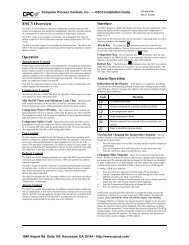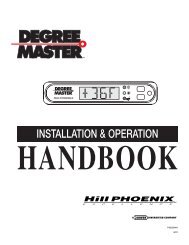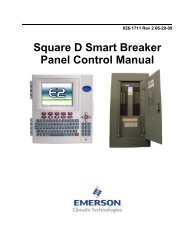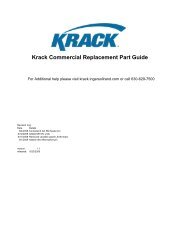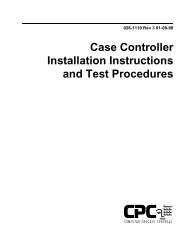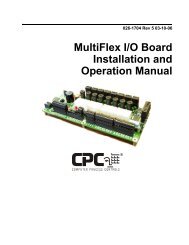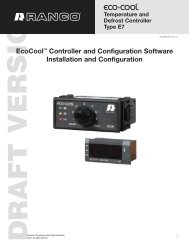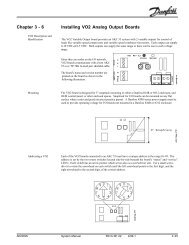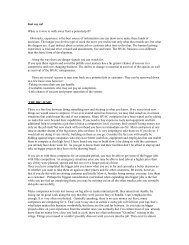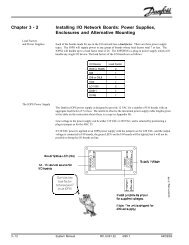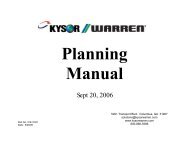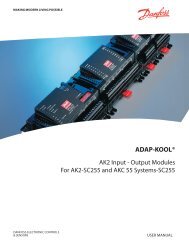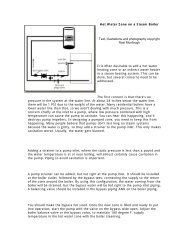352-00161-001 HUSSMANN - English - icemeister.net
352-00161-001 HUSSMANN - English - icemeister.net
352-00161-001 HUSSMANN - English - icemeister.net
You also want an ePaper? Increase the reach of your titles
YUMPU automatically turns print PDFs into web optimized ePapers that Google loves.
Temperature and<br />
Defrost Controller<br />
USER INSTRUCTIONS<br />
Your refrigerated case uses a Hussmann Safe-NET TM III temperature and<br />
defrost controller to precisely maintain the temperature and prevent frost<br />
buildup on the cooling coil. LEDs indicate when the compressor or<br />
refrigeration is on, when the case is in a defrost cycle, if the temperature is<br />
outside the desired range, or if there is a sensor failure. An adjustment knob<br />
allows the temperature to be set within the configured range and can power<br />
off the controller and compressor. Your controller has been custom-configured<br />
to provide the best temperature and defrost control for your chilled or frozen<br />
food.<br />
The front of the controller has an adjustment knob and status LEDs. The back<br />
of the controller has connections for sensors and switched equipment.<br />
1
The Safe-NET III controller includes the following features and connections.<br />
• Adjustment knob:<br />
Adjusts the temperature setpoint.<br />
May include an Off Position to turn off the controller, refrigeration, and<br />
defrost heat and fan.<br />
See Your Case Configuration on page 7.<br />
WARNING: The optional evaporator fan remains ON when the<br />
adjustment knob is in the Off position.<br />
• Controller LEDs:<br />
Compressor Powered On LED (green):<br />
Lights while the compressor is running or the refrigeration valve<br />
is open.<br />
Defrost Cycle LED (yellow):<br />
Lights while the refrigeration coil is defrosting.<br />
Temperature or Sensor Alarm (red):<br />
Lights if the temperature is too warm or too cold.<br />
Flashes if a sensor fails.<br />
See Alarms and Codes on page 7.<br />
• Rear connections:<br />
– Case temperature sensor:<br />
Typically senses the temperature of the air in the case.<br />
Used by the controller to determine when to power on or power off<br />
the compressor or refrigeration.<br />
– Evaporator temperature sensor:<br />
Senses the temperature of the refrigeration coil.<br />
Terminates a defrost cycle when refrigeration coil ice melts.<br />
– Compressor or refrigeration relay:<br />
Switches on the compressor or refrigeration valve for cooling.<br />
– Defrost relay:<br />
The Safe-NET III controller includes a defrost relay that switches on<br />
the optional evaporator fan during normal operation and switches on<br />
the defrost heater during a defrost cycle.<br />
2
Display<br />
The display includes three red LEDs and two digits for temperature, defrost<br />
status, and error codes.<br />
The three display LEDs are red, and their behavior matches the LEDs on the<br />
controller.<br />
Startup<br />
1. Plug in the case.<br />
WARNING: The Off Position does not disconnect line voltage to the case,<br />
refrigeration unit, fan, or heater.<br />
2. Wait for the self check to complete. During the self check, each LED<br />
flashes for one second, then all LEDs turn on for two seconds. If the<br />
LEDs do not flash, make sure the adjustment knob is not in the Off<br />
position. (See Your Case Configuration on page 7 for Off position<br />
functionality.)<br />
• After the self check, all LEDs turn off until the compressor starts.<br />
There may be a delay before the compressor starts.<br />
If the red Temperature or Sensor Alarm LED stays on after the self<br />
check, see Alarms and Codes on page 4.<br />
• The green Compressor Powered On LED turns on when the<br />
compressor starts.<br />
Temperature Adjustment<br />
Rotate the adjustment knob counter clockwise for a warmer setpoint or<br />
clockwise for a colder setpoint.<br />
• While you are adjusting the temperature, the optional display shows the<br />
setpoint (cut out value). A few seconds after you set the temperature, it<br />
reverts to showing the sensed temperature in the case.<br />
3
1<br />
2<br />
6<br />
7<br />
1<br />
2<br />
6<br />
7<br />
1<br />
2<br />
6<br />
7<br />
Alarms and Codes<br />
Flashing Temperature or Sensor Alarm LED, E1 or E2<br />
If the Temperature or Sensor Alarm LED (red) on the controller and display is<br />
flashing, a temperature sensor has failed. The display shows E1 if the case<br />
sensor has failed or E2 if the evaporator sensor has failed. (See Alarms and<br />
Codes on page 7.)<br />
If the case sensor fails, depending on the configuration of your controller,<br />
refrigeration will run continuously, turn off, or repeat a duty cycle of a few<br />
minutes on and a few minutes off. The graph below shows an example of duty<br />
cycle operation during a case sensor failure.<br />
Compressor<br />
Off Time If<br />
sensor Failed<br />
Compressor<br />
On Time If<br />
sensor Failed<br />
On<br />
Compressor or<br />
Refrigeration<br />
Status<br />
Off On Off On<br />
Off<br />
Defrost Termination Switch<br />
Your case may use a defrost termination switch, instead of an evaporator<br />
sensor, to terminate a defrost cycle. The defrost termination switch is<br />
temperature activated and senses the completion of defrost. Your Case<br />
Configuration on page 7 shows whether your case includes a defrost<br />
termination switch.<br />
Manual Defrost<br />
Time<br />
3<br />
4<br />
5<br />
3<br />
4<br />
5<br />
3<br />
4<br />
5<br />
I<br />
Warm<br />
I<br />
Cold<br />
1. Note location of knob<br />
setting.<br />
I<br />
Warm<br />
I<br />
Cold<br />
2. Rotate knob fully<br />
counterclockwise until<br />
it stops (full warm –<br />
“OFF” position).<br />
I<br />
I<br />
Warm Cold<br />
3. After 10 seconds, but<br />
before 30 seconds,<br />
rotate knob fully<br />
clockwise until it stops<br />
(full cold position).<br />
Note: The above procedure initiates a manual or forced defrost.<br />
The control has protective settings to prevent short cycling of the compressor.<br />
A. The compressor may run for as long as 1 minute after step 2 is<br />
completed. Start the 10 second count down, for step 3, once the display<br />
is blank.<br />
4
B. The defrost initiation may be delayed for as long as 2 minutes after step<br />
3 is completed.<br />
The display will show “dF” once step 3 is completed, even with the protective<br />
delay timing out. The “dF” will display for a while after defrost has terminated,<br />
to allow the temperature to stabilize.<br />
CAUTION: Return the control knob to its original setting (Step 1) once<br />
the manual defrost has been initiated.<br />
Evaporator Fan Delay<br />
On low temperature models, an evaporator fan delay is incorporated to delay<br />
the fan operation until the evaporator is below its setpoint temperature,<br />
following a defrost cycle.<br />
On some low temperature models, the evaporator fan is briefly cycled to<br />
dissipate the presence of vapor during the defrost cycle.<br />
Service Procedures (for service personnel only)<br />
Installing a configuration file into a controller from a copy card<br />
The copy card allows service personnel to update the configuration of<br />
a controller.<br />
CAUTION: This procedure must be followed exactly or the controller<br />
may be damaged.<br />
1. Disconnect power to the case (the controller must be powered off).<br />
*2. Connect the copy card to the controller.<br />
3. Make sure the adjustment knob is not in the Off position.<br />
4. To start the installation, reconnect power to the case (the controller<br />
should be powered on).<br />
a. During the file transfer, both LEDs on the copy card turn on.<br />
b. When the data transfer has completed, the green LED remains on<br />
and the red LED turns off.<br />
c. If the red LED remains on and the green LED is off, the transfer failed.<br />
d. If the transfer fails, repeat step 1 through step 4. If it fails again, use<br />
a different copy card or controller.<br />
5. Disconnect power to the case (the controller is powered off).<br />
6. Disconnect the copy card from the controller.<br />
7. Reconnect power to the case (the controller is powered on).<br />
Note: The above procedure can be easily performed through the display<br />
5
interface cable, using the addition of a jumper to adapt the connection<br />
to the copy card.<br />
* At Step 2 above:<br />
Disconnect the cable from the rear of the display module and attach it<br />
to the copy card using the jumper. Proceed with Step 3 through Step 7.<br />
Wiring Examples<br />
WARNING: Before wiring the controller, make sure that the<br />
refrigeration unit, fan, heater, and controller are not<br />
connected to the electrical supply. Do not apply voltage to<br />
the digital input.<br />
Safe-NET III Controller<br />
Digital Input D.I.<br />
Common<br />
Evaporator Temperature Sensor P2<br />
Control Sensor Pb1<br />
Interface box and<br />
copy card TTL connector<br />
Defrost Termination<br />
Switch (NO) (optional)<br />
Optional Evaporator Sensor<br />
Control Sensor (Air Space)<br />
Line 1<br />
Line 2<br />
Compressor<br />
Phase<br />
Fan<br />
Phase<br />
Heater<br />
90-240Vac<br />
Line Supply<br />
Compressor<br />
AC Line Supply<br />
Defrost Fan (optional)<br />
AC Line Supply<br />
AC Line Supply<br />
Defrost Heater (optional)<br />
6
Your Case Configuration<br />
Factory Setting<br />
Adjustment knob has Off position.<br />
Average product temperature -10˚F.<br />
Knob position #5<br />
Yes<br />
Delay before compressor runs after startup.<br />
Delay Time 30 sec.<br />
Compressor operation if case sensor fails.<br />
Compressor On<br />
What the display shows during defrost?<br />
dF<br />
The case defrosts when the power is turned<br />
on.<br />
Yes<br />
The method used to end defrost.<br />
Evaporator Sensor Temperature<br />
Defrost terminated by termination switch<br />
No<br />
Alarms and Codes<br />
Alarm or Code Indicates Action<br />
Red LED remains<br />
on after startup.<br />
Red LED turns on<br />
during operation.<br />
Firmware corruption on<br />
controller.<br />
Controller is not operating.<br />
Case temperature is too<br />
warm or too cool.<br />
Call service immediately.<br />
Make sure the door is closed.<br />
Make sure that cold air is not being<br />
blocked or deflected.<br />
Make sure that the evaporator coil<br />
is not iced up.<br />
Check the temperature using the<br />
optional display or a thermometer.<br />
If the LED does not turn off after<br />
one hour call service.<br />
Red LED flashes.<br />
Temperature sensor failure.<br />
E1 indicates a case<br />
temperature failure.<br />
E2 indicates an evaporator<br />
temperature sensor failure.<br />
Check the optional display for error<br />
code E1 or E2 and call service<br />
immediately.<br />
7
Hussmann Corporation<br />
Ingersoll Rand Climate Control Technologies<br />
12999 St. Charles Rock Road<br />
Bridgeton, MO 63044<br />
www.hussmann.com<br />
©2009 Invensys Controls. All Rights Reserved.<br />
8



